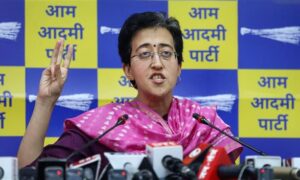New Delhi [India]: Chandrayaan-3 has proved India’s capability for cost-effective space missions, said Union Minister of State for Space Jitendra Singh.
Speaking at an interactive meet of intellectuals, prominent citizens and media persons in Indore on Saturday, “The Russian moon mission, that was unsuccessful, cost Rs 16,000 crore, and our (Chandrayaan-3) mission cost just around Rs 600 crore. Consider, Hollywood films based on moon and space Missions cost over Rs 600 crore.”
He said India’s space missions are designed in such a way that it is cost-effective. India, he said, has learned to compensate for costs through skills.
“Questions will arise, how? We made use of gravitational forces, the spacecraft made about 20 orbits of the earth, each rising in parabola, until it escaped and was captured in the Moon’s gravity and it made 70-80 revolutions of the moon before landing at the designated spot,” he said.
Jitendra Singh said that in order to involve the private sector in R&D efforts, Prime Minister Narendra Modi came out with the “Anusandhan National Research Foundation” Bill, passed by the Lok Sabha in the last session of Parliament, with a budget of Rs 50,000 crore for over five years.
“When it is implemented fully, it will be a game-changer. We are planning a unique Public Private Partnership (PPP) entity for which Rs 36,000 crore of the research funding is to come from the private sector, mostly industry whereas the Government will put Rs 14,000 crore,” he said.
“We have to take this off our minds that the Government will and should do everything, those countries that stand developed did not achieve it by depending solely on their government. If today NASA sends rockets for the US, the maximum contribution to such missions is made by private agencies and industry, ” the minister said.
India took a giant leap on Wednesday evening as the Chandrayaan-3 lander module successfully landed on the moon’s South Pole, making it the first country to have achieved the historic feat and bringing to an end the disappointment over the crash landing of the Chandrayaan-2, four years ago.
Overall, India became the fourth country – after the US, China, and Russia – to have successfully landed on the moon’s surface.
Upon landing, the Vikram lander and the Pragyan rover were to operate and do their set tasks and experiments for one lunar day. One day on the Moon is equal to 14 days on Earth.
In its latest update, ISRO said “Conducting in-situ scientific experiments (by Chandrayaan-3) is underway. All payloads are performing normally.”
The stated objectives of Chandrayaan-3, India’s third lunar mission, were a safe and soft landing on the lunar surface, the rover moving on the moon’s surface, and in-situ scientific experiments.
The spacecraft was launched from the Satish Dhawan Space Centre in Andhra Pradesh’s Sriharikota on July 14.

























